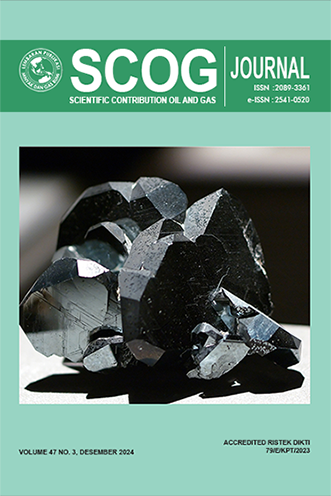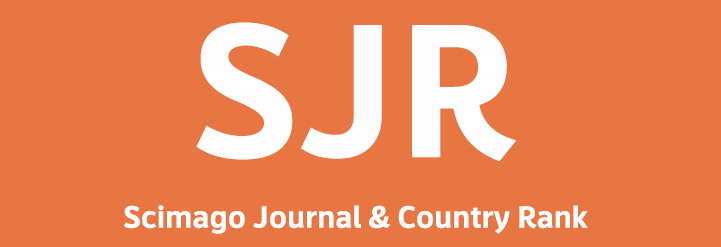Organic Thermal Maturity Based on Color Index of Halang Formation, Banyumas Basin, Central Java, Indonesia
DOI:
https://doi.org/10.29017/SCOG.47.3.1636Keywords:
halang formation, pollen, spores, thermal alteration, thermal maturity indexAbstract
We analyzed palinomorfs and foraminifera fossils on two samples taken from the claystone layer of the Halang Formation. We conducted this analysis to evaluate the thermal maturity of the sample as well as to determine its age and depositional environment. Both samples contained poor amounts of pollen, spores, dinoflagellate, and diatom, but they contained abundant foraminifera. In these two samples, pollens, spores, dinoflagellates, and diatom were primarily black or blackish, gray to dark brown—the color of the foraminifera tests was also dark, principally gray. No index fossils were found in the pollen assemblages. However, the presence of Spinizonocolpites echinatus, Monoporites annulatus, and Pinuspollenites type indicates the samples are not older than the Paleocene. The foraminifera assemblage in both samples suggests that the age of the samples is Early Pliocene. The lack of pollen grains and spores and the abundance of foraminifera indicate that the depositional environment of the two samples was offshore. Melonis pompiliodes, Cibicidoides wuellerstorfi, and Bulimina affinis suggest these samples were deposited in a lower slope/lower bathyal environment. The color of the pollen, spore, dinoflagellate, diatom, and foraminifera fossils indicates the degree of thermal maturity of the samples have reached a mature or dry gas (barren) level. The high level of thermal maturity of the relatively young Halang Formation is supposed to be related to the presence of post-depositional volcanic activitiesReferences
Alaug, A.S., 2010. Source rocks evaluation, hydrocarbon generation and palynofacies study of late cretaceous succession at 16/G-1 offshore well in Qamar Basin, eastern Yemen. Arabian Journal of Geosciences. DOI 10.1007/s12517-010-0182-6
Armandita, C., Mukti, M.M., Satyana, A.H., 2009. Intra-arc trans-tension duplex of Majalengka to Banyumas area : prolific petroleum seeps and opportunities in West-Central Java border. Proceedings, Indonesian Petroleum Association, Thirty-Third Annual Convention & Exhibition, IPA09-G-173.
Bellonzi, T.K., Dutra, F.V., de Souza, C.N., Rezende, A. A., Gasparino, E.C., 2020. Pollen types of Sapindaceae from Brazilian forest fragments: apertural variation. Acta Bot. Bras., 34(2).
Blow, W.H., 1969. Late Middle Eocene to Recent Planktonic Foraminifera Biostratigraphy. Conv Planktonic Micro Fossils, Leid Nederland, E.J., Vol 1, Geneva.
De Vernal, A., 2014. Palynology (Pollen, Spore, etc). Encyclopedia of Marine Geosciences, 1-11.
Goodhue, R. and Clayton, G., 2010. Palynomorph Darkness Index (PDI) – a new technique for assessing thermal maturity. Palynology 34, 147-156.
Gutjahr, C.C.M., 1966. Carbonization meaurements of pollen-grains and spores and their application. Leidse Geologische Mededelingen, Vol. 30, 1-29.
Hartkopf-Fröder, C., Königshof, P., Littke, R., Schwarzbauer, J., 2015. Optical thermal maturity parameters and organic geochemical alteration at low grade diagenesis to anchimetamorphism: A review. International Journal of Coal Geology 150–151, 74–119.
Haseldonckx, P., 1979. Relation of palynomorph color and sedimentary organic matter to thermal maturation and hydrocarbon generating potential. CCOP Technical Bulletin 6, 41-53.
Izati, C.N., Putra, A.H.A., Gibran, A.K., Saputro, S.D. Karunia, W.O., 2013. Distribution of gas seep near subsurface and its type using electrical method and geochemical análisis in Jatilawang, Banyumas. Proceedings, Indonesian Petroleum Association, Thirty-sevent Annual Convention & Exhibition, IPA13-SG-115.
Jiang, D., Robbins, E.I., Wang, Y., Yang, H., 2016. Spore/Pollen Fossil Coloration and Petroleum Source Rock Quality. In: Jiang, D., Robbins, E.I., Wang, Y., Yang, H. (Eds.), Petrolipalynology. Springer Berlin Heidelberg, 123-127.
Marshall, J.E.A. and Yule, B.L., 1999. Spore color measurement. In: Jones, T.P., Rowe, N.P. (Eds.), Fossil Plants and Spores: Modern Techniques. Geological Society, London, 165-168.
McNeil, D.H., Issler, D.R., Snowdon, L.R., 1996. Colour alteration, thermal maturity, and burial diagenesis in fossil foraminifers, Ottawa, Geological Survey of Canada Bulletin 499, 34p.
Morley, R.J., 1991. Tertiary stratigraphic palynology in Southeast As.ia: current status and new directions. Geol. Soc. Malaysia, Bulletin 28, 1-36.
Muchsin, N., Ryacudu, R., Kunto, T.W., Sribudiyani, Yulihanto, B., Wiyanto, B., Nurjayadi, A., Rahardjo, K., and Riandra, F., 2002, Miocene hydrocarbon system of the southern Central Java region. Proceedings the 31st Annual Convention of Indonesian Association of Geologists, 58-67.
Noeradi, D., Subroto, E.A., Wahono, H.E., Hermanto, E., and Zaim, Y., 2006, Basin evolution and hydrocarbon potential of Majalengka-Bumiayu transpression basin, Java Island, Indonesia. Proceedings AAPG International Conference and Exhibition, Perth. Soft file CD version.
Pearson, D.L., 1984. Pollen/Spore Color Standard, Version #2. Phillips Petroleum Company, Exploration Project Sec- tion. Bartelsville, Oklahoma.
Pross, J., Pletsch, T., Shillington, D. J., Ligouis, B., Schellenberg, F., Kus, J., 2007. Thermalalteration of terrestrial palynomorphs in mid-Cretaceous organic-rich mudstones intruded by an igneous sill (Newfoundland Margin, ODP Hole 1276A). International Journal of Coal Geology, 70, 277-291.
Satyana, A.H., 2006, New insight of Tectonics of Central Java, Indonesia and its petroleum implications. Proceedings AAPG International Conference and Exhibition, Perth. Soft file CD version.
Setiawan, R., 2018. Laporan Internal Pendahuluan. Pusat Survei Geologi, Badan Geologi.
Spina, A., Vecoli, M., Riboulleau, A., Clayton, G., Cirilli, S., Michele, A.D., Marcogiuseppe, A., Rettori, R., Sassi, P., Servais, T., Riquier, L., 2018. Application of Palynomorph Darkness Index (PDI) to assess the thermal maturity of palynomorphs: A case study from North Africa. International Journal of Coal Geology, 188, 64-78.
Staplin, F.L., 1969. Sedimentary organic matter, organic metamorphism and oil and gas occurrence. Bull. Canadian Petroleum Geology 17, 47–66.
Subroto, E.A., Wahono, H.E., Hermanto, E., Noeradi, D., and Zaim, Y., 2006, Re-evaluation of the petroleum potential in Central Java Province, Indonesia: Innovative approach using geochemical inversion and modelling. Proceedings AAPG International Conference and Exhibition, Perth. Soft file CD version.
Subroto, A.S., Noeradi, D., Priyono, A., Wahono, H.E., Hermanto, E., Praptisih, Santoso, K., 2007. The Paleogene Basin within the Kendeng Zone, Central Java Island, and implications to hydrocarbon prospectivity. Proceedings, Indonesian Petroleum Association Thirty-first Annual Convention & Exhibition, IPA07-G-091.
Yule, B.L., Roberts, S., Marshall, J.E.A., 2000. The thermal evolution of sporopollenin. Organic Geochemistry 31, 859–870.
Downloads
Published
Issue
Section
License
Copyright (c) 2024 SCIENTIFIC CONTRIBUTIONS OIL AND GAS (SCOG)

This work is licensed under a Creative Commons Attribution 4.0 International License.
Authors are free to Share — copy and redistribute the material in any medium or format for any purpose, even commercially Adapt — remix, transform, and build upon the material for any purpose, even commercially.
The licensor cannot revoke these freedoms as long as you follow the license terms, under the following terms Attribution — You must give appropriate credit , provide a link to the license, and indicate if changes were made . You may do so in any reasonable manner, but not in any way that suggests the licensor endorses you or your use.
No additional restrictions — You may not apply legal terms or technological measures that legally restrict others from doing anything the license permits.














